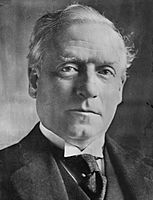Asquith coalition ministry facts for kids
Quick facts for kids Asquith coalition ministry |
|
|---|---|
| 1915–1916 | |
 |
|
| Date formed | 25 May 1915 |
| Date dissolved | 5 December 1916 |
| People and organisations | |
| Monarch | George V |
| Prime Minister | H. H. Asquith (pictured) |
| Prime Minister's history | 1908–1916 |
| Total no. of members | 85 appointments |
| Member parties | |
| Status in legislature | Majority (coalition) |
| Opposition party |
Opposition Conservative Party
(1915–1916) |
| Opposition leader |
Sir Edward Carson
(1915–1916) |
| History | |
| Legislature term(s) | 30th UK Parliament |
| Predecessor | Third Asquith ministry |
| Successor | Lloyd George war ministry |
The Asquith coalition ministry was the government of the United Kingdom led by H. H. Asquith. He was the Prime Minister and a member of the Liberal Party. This government was formed in May 1915 and lasted until December 1916. It was a special type of government called a coalition. This means that different political parties worked together as a team. This happened nine months after World War I began. The government ended when the Conservative Party decided to leave the coalition.
Contents
Why the Coalition Formed
When World War I started in 1914, Britain needed a strong and united government. The war was a huge challenge for the country. To face this challenge, the main political parties decided to work together. This included the Liberal Party, the Conservative Party, and the Labour Party.
Joining Forces for War
The idea was that by combining their strengths, they could lead the country better during wartime. This new government was formed on May 25, 1915. It brought together leaders from different parties.
How the Government Worked
In this new government, the Prime Minister, H. H. Asquith, was a Liberal. His main team of advisors, called the Cabinet, included members from all three parties. There were nine Conservatives and one Labour minister. However, the Liberal Party still held most of the very important jobs.
Challenges and Disagreements
Even though they were working together, there were still disagreements. The Conservative Party wanted more important roles in the Cabinet. Their leader, Bonar Law, often spoke out against the way things were being run. This showed that even in a coalition, different parties can have different ideas.
The End of the Asquith Government
The Asquith coalition government faced many challenges during the war. Over time, the disagreements between the parties grew. The Conservative Party became more and more unhappy with Asquith's leadership.
A New Leader Emerges
On December 5, 1916, the Conservative ministers decided to resign. They refused to continue serving under Asquith. This caused the government to collapse. Asquith and most of the Liberals then moved into opposition. The very next day, a new government was formed. This new coalition was led by David Lloyd George. He was also a Liberal, but he had the support of the Conservatives. This change marked a big moment in Britain's wartime leadership.
Key Government Roles
Here are some of the important jobs in the Asquith government:
- Prime Minister: H. H. Asquith (Liberal)
- Chancellor of the Exchequer (in charge of the country's money): Reginald McKenna (Liberal)
- Lord Chancellor (top legal official): The Lord Buckmaster (Liberal)
- Secretary of State for Foreign Affairs (deals with other countries): Sir Edward Grey (Liberal)
- Secretary of State for War (in charge of the army): The Earl Kitchener (Independent), then David Lloyd George (Liberal)
- First Lord of the Admiralty (in charge of the navy): Arthur Balfour (Conservative)
- Secretary of State for the Colonies (managed British colonies): Bonar Law (Conservative)
- Minister of Munitions (in charge of making weapons and supplies for the war): David Lloyd George (Liberal), then Edwin Samuel Montagu (Liberal)
- President of the Board of Education (in charge of schools): Arthur Henderson (Labour)
See Also

